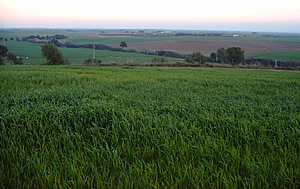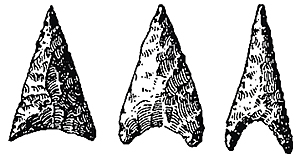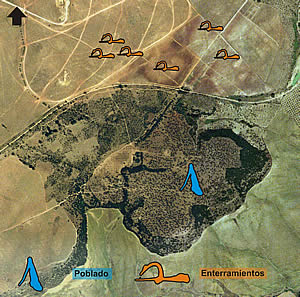

What meant agriculture? Firstly, it meant to have a regular source of food, through the seasonal cultivation of certain plants. Besides, it resulted in an each time higher tendency towards sedentary life, and the appearance of the first permanent villages. Finally, the exchange between communities favoured the development of commerce, and the situation of the settlements next to road or in the surroundings of the areas of agricultural production.
The Neolithic presence is associated to small tools of carved stone (microliths), used for, among other aims, as barbs of sickles to reap crops. But above all, Neolithic marks the appearing of pottery, with receptacles made by hand and used to cook and store food: cups, cooking pots...

In the area of Alcalá there are few Neolithic sites, all of them are located southern the present municipal district, at the surroundings of the Guadairilla brook. These sites (Cortijo Gallegos, Carretera de Morón) are placed in the countryside, fit for the primitive farming, in hillocks close to water courses and possibly to historic roads, like the Cordel del Gallegos.
The first Neolithic settlements give way to Chalcolithic villages that are developed throughout the third millennium BCE. Why does its name change? It is due mainly to the beginning of the use of metals, in this case copper, which gives name to the entire Age (Copper Age). But there are other circumstances that may also be more important. Firstly, agricultural economy is intensified, and consequently sedentary life and the presence of permanent villages, even of certain size, are increased. Pottery usage becomes popular, with characteristic receptacles: Dishes of thickened borders, bowls and globular pots, cylindrical cups. All these pieces appear in sites over the whole peninsular South, as a proof of the commercial exchanges or even the presence of itinerant potters (technicians). Finally, new stone tools also appeared: Flint knives, handheld mills, balls to grind the cereal and polished stone axes.

Chalcolithic sites make the area of Neolithic presence larger, especially at the countryside. We can find them around the Guadairilla and Guadaíra's valleys, at hillocks of easy access to the water courses and to the farming plots. How were these villages? They would be mostly settlements of small size, dedicated to agriculture and cattle farming -this late one possibly with migrating character, that would make the villages seasonal settlements.
But jointly to a higher number of small villages, in the Chalcolithic there appear other settlements of bigger size, sometimes walled and with signs of spaces for collective burial. They are often understood as the result of several factors combination: Singular situation, generally in high areas with access to roads of certain importance, storage of the surroundings agricultural production and defensive function before possible sackings. All of it suggests an initial form of political organization, with possibly a certain degree of control on the surrounding territory.

In Alcalá's area, the most important enclave during the Chalcolithic is located at the Mesa (Small Plateau) de Gandul. This site is placed in the southeast escarpment of Los Alcores, between the present towns of Alcalá de Guadaíra and Mairena del Alcor. It seems that it is during the Chalcolithic when the small plateau becomes populated for the first time, and although we do not know how the village was, what we do know is the great zone of burials arranged around. It is a vast group of megalithic graves, made of large stones covering circular chambers excavated on the ground, accessed by a corridor equally covered: Del Vaquero cave, de la Casilla dolmen, Cañada Honda graves... The graves were covered by a circular mound of earth and stones, creating a funerary landscape similar to those other Chalcolithic sites, like the ones of Aljarafe.
The relative abundance of agricultural villages during the third millennium BCE gives way during the second millennium BCE to a lower number of settlements. It is the period known as Bronze Age, during which a combination of less rainfall and higher temperatures affected the agricultural economy, along with a concentration of human groups in less villages than in the previous period.
Along the Age of Bronze the settlement of Mesa de Gandul and the use of the funerary surrounding zone were maintained. But maybe the most prominent fact is the stable settlement for the first time of the Castle Hill, placed on a rise of the ground beside River Guadaíra. The village of the Castle Hill was walled, with circular huts inside, and was inhabited and developed up to 1500 BCE, when it seems to have been destroyed, and it is supposed that the village was inhabited for several centuries.
